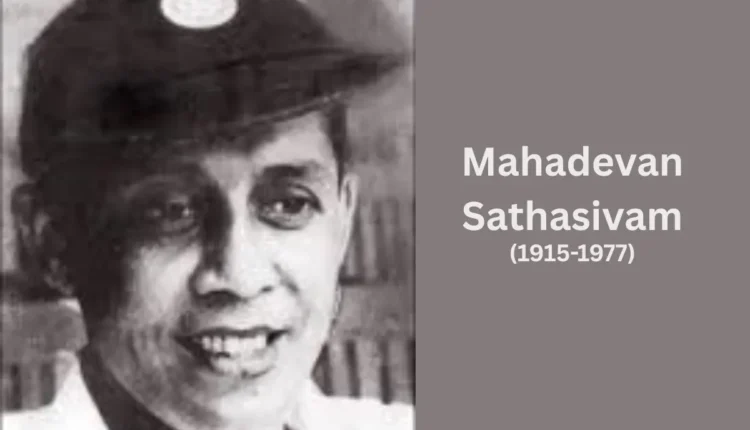In the pantheon of cricketing legends, there are names that echo through generations—Bradman, Sobers, Worrell. Yet hidden in the folds of cricket’s colonial chapters is the story of a man who stood shoulder to shoulder with giants and was revered even more intimately by those who saw him bat. Mahadevan Sathasivam, the pride of Ceylon, was more than just a batsman—he was a phenomenon, a poetic enigma carved into the annals of the sport.
Sir Garfield Sobers called him “the greatest batsman ever on earth,” and Sir Frank Worrell—no less a legend—declared he was the best he had ever seen. Yet, Satha’s name does not resound with the fanfare of modern fame. Why? Perhaps because his story, brilliant and bruised, was too raw, too real, too human to be easily mythologized. But today, we unveil the legend in full—the man, the maestro, the myth, and the miracle.
Mahadevan Sathasivam: A Star Is Born in Ceylon
Born on October 18, 1915, in the lush island of Ceylon (now Sri Lanka), Mahadevan Sathasivam was destined to shine. From the beginning, the streets of Colombo and the corridors of St. Joseph’s College and Wesley College echoed with the sounds of a boy wielding a bat with a grace and aggression seldom seen.
At just 15, Mahadevan Sathasivam began his cricketing career, leaving spectators stunned with innings that felt more like ballet than sport. His 145-run epic against S. Thomas’ College in 1936, played on the coastal grounds of Mount Lavinia, was a schoolboy performance still whispered in awe.
The war would briefly interrupt his flow as he took up arms as a Second Lieutenant in the Ceylon Light Infantry in 1940. Yet, even in khaki, cricket pulsed through his veins.
A Batting God Among Mortals
Mahadevan Sathasivam’s first match for Ceylon came in 1945. But it was not merely an appearance—it was a revelation. Against a visiting Indian side, he carved out a glorious 111 runs, announcing to the world that Ceylon had birthed a genius.
In 1947, on the hallowed turf of Chepauk in Madras, he etched his name into history with a staggering 215, eclipsing the previous record set by West Indian Jeff Stollmeyer. Facing Test-level bowlers like M.J. Gopalan and Ram Singh, Sathasivam was a painter, and his bat was the brush.
The innings sparked waves through India, with crowds dubbing it “the finest knock ever seen on this ground.” When he took to the field against Don Bradman’s Australia in 1948, leading the Ceylon side, it felt like the crowning of a cricketing prince. And yet, this was only the beginning.
The Captain of Three Nations
Mahadevan Sathasivam is, remarkably, the only man in cricketing history to captain three national teams: Ceylon, Singapore, and Malaysia. That feat alone speaks volumes. But for Satha, leadership wasn’t just about strategy—it was about elegance, charisma, and artistry.
He wasn’t a cricketer. He was a spectacle.
The Tragedy and Triumph of the Murder Trial
But every legend must walk through fire. In 1951, the brilliant cricketer found himself in a horrifying storm—accused of murdering his estranged wife, Paripoornam Ananda Rajendra. The media roared. Society recoiled. Overnight, Satha was no longer a hero—he was a villain in the public eye.
Yet the case, with all its dramatic turns, was an epic in itself. Behind the scenes, his defense was built with meticulous brilliance, led by the indomitable Dr. Colvin R. de Silva. The defense flew in Sir Sydney Smith, one of the world’s foremost forensic pathologists, who dissected every inconsistency and exposed the cracks in the prosecution’s case.
After 20 harrowing months in remand prison, Sathasivam walked free—unanimously acquitted by the jury. Justice Gratiaen’s words rang clear: “You are now free.”
Mahadevan Sathasivam’s name had been dragged through fire. But he emerged, not burnt, but tempered—a phoenix reborn.
The Second Innings of Life
The world had changed. Ceylon had changed. But Satha’s love for cricket had not.
Mahadevan Sathasivam married Yvonne Stevenson in London in 1953 and began a new chapter in Singapore and Malaysia, once again leading national sides, once again letting his bat speak the language of genius.
In 1953, Mahadevan Sathasivam dazzled crowds in England with a sublime 153 not out against the Indian Gymkhana Club. In 1955, he closed the curtains of his career in Ceylon with a majestic 206 not out against Government Services.
This was not a man haunted by his past—this was a man who had owned it, overcome it, and risen above it.
Legacy of a Legend
Mahadevan Sathasivam passed away on July 9, 1977, in Colombo, but his story is not buried with him. It lives in whispered stories from elders to grandchildren. It lives in the echoes of Chepauk, in the shadows of the Nondescripts Cricket Club, and in the immortal words of Garry Sobers and Frank Worrell.
He was a hero forged by cricket, tested by life, and remembered by the truth.
Also Read : Thirunalan Sasitharan: The Mind Behind Intercultural Theatre Institute’s Global Impact

